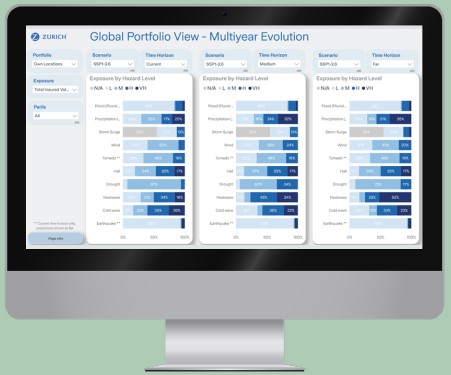Navigating Climate Change: The Importance of Supply Chain Resilience
09/22/2024
Climate change is a big challenge for everyone. It’s making the environment more unpredictable, and that means businesses around the world are at risk from things like hurricanes, floods, wildfires, extreme heat, extreme cold and droughts. These threats can disrupt supply chains and make them less efficient and resilient. So, lots of businesses now see reducing these risks as a really important part of their strategy.
The Economic Impact of Supply Chain Disruptions
The economic implications of climate-related supply chain disruptions are profound.
Financial losses can result from damaged infrastructure, business interruptions and reduced supply. The interconnected nature of modern supply chains means that the impact of climate risks on one asset can reverberate through the entire chain, through lost revenue and increased costs.
Examples of real-life supply chain losses due to climate related issues include Hurricane Harvey’s impact on the petrochemical industry, Thai floods in 2011 and the more recent bushfires in Australia in 2019/2020.
Regulatory Landscape of Supply Chains
The regulatory landscape for climate related supply chain risks is multifaceted. Climate-related disclosure requirements help to understand both the environmental impact of an organisation’s operations and the impacts on of climate change on operations. Some of the key standards and frameworks addressing supply chain-related disclosures include:
- Task Force on Climate-related Financial Disclosures (TCFD) – Focusing on Scope 3 greenhouse gas emissions and climate risks in the supply chain.
- Global Reporting Initiative (GRI) - requires organisations to report on scope 3 emissions
- Carbon Disclosure Project (CDP) - offers a supply chain program for organisations to report on climate-related impacts, including emissions, water use, and deforestation risks.
- Corporate Sustainability Reporting Directive (CSRD) - Large companies of a certain size will be required to disclose information about their supply chains which includes environmental impacts. They will also have to disclose how they conduct due diligence on their supply chains concerning environmental and social impacts.
- Corporate Sustainability Due Diligence Directive (CSDDD) - focuses on enhancing corporate governance and sustainability practices, particularly human rights, environmental issues, and climate change across global supply chains.
These disclosures aim to increase transparency and enable investors and stakeholders to make informed decisions. Governments are setting stricter emissions reduction targets, affecting supply chains, especially in heavy-polluting industries, potentially leading to increased costs for the organisations impacted and the need for supply chain adjustments.
Some of these standards and frameworks require increased visibility into the multi-tiers of the supply chains of organisations but sometimes there is difficulty in mapping these chains beyond those suppliers that organisations work directly with.
Drivers for Resilience and Adaptation Standards
Organisations are increasingly mandated to implement measures enhancing supply chain resilience against climate-related disruptions. This includes investing in infrastructure improvements, diversifying suppliers, and developing contingency plans for extreme weather events.
- Trade and Tariff Policies: Climate considerations are increasingly reflected in trade policies. Tariffs or restrictions could be imposed on goods from countries not meeting climate standards, affecting material and product costs and availability.
- Financial Regulations and Incentives: Organisations demonstrating strong climate risk management and sustainability practices may gain better access to financing, while those who do not might face higher borrowing costs or reduced investment opportunities.
- Product and Packaging Regulations: Regulations aimed at reducing the environmental impact target product design and packaging, requiring recyclability, reduced waste, and lower carbon footprints, needing supply chain adaptations.
- Insurance and Risk Management Requirements: As physical climate risks become more pronounced, insurance organisations adjust coverage and premiums. Organisations may face higher insurance costs or difficulty obtaining cover, meaning more comprehensive risk management strategies, including integrating climate risk assessments into business continuity planning.
- Labour and Human Rights Regulations: Climate change can exacerbate labour and human rights issues, such as forced migration and unsafe working conditions. Regulations may require organisations to address these issues within their supply chains, ensuring fair labour practices, improving working conditions, and supporting communities affected by climate change.
Strategies for Mitigating Climate Risks
To build resilient supply chains, businesses must adopt four risk management strategies:
- Diversify Supply Sources: Organisations should geographically diversify their supplier base to mitigate the risk of regional climate events affecting their entire supply chain. Sourcing from multiple regions ensures that disruptions in one area do not halt overall production.
- Invest in Predictive Analytics: Leveraging predictive analytics and climate modelling helps businesses anticipate and prepare for potential disruptions. Advanced data analytics provide insights into weather patterns and potential risks, enabling proactive measures to safeguard supply chains.
- Enhance Infrastructure Resilience: Investing in resilient infrastructure is crucial. This includes fortifying physical assets against extreme weather and developing robust contingency plans to maintain operations during disruptions.
- Collaborative Risk Management: Collaboration with suppliers, logistics partners, and other stakeholders is essential for effective risk management. Joint efforts in developing risk mitigation strategies and sharing best practices can enhance overall supply chain resilience.
As climate change continues to pose significant risks to global supply chains, businesses must proactively enhance resilience to ensure continuity. By understanding regulatory requirements, leveraging technology, and fostering collaboration, organisations can mitigate the impacts of climate-related disruptions and secure their supply chains for the future.
How can we help?
At Zurich Resilience Solutions we offer a Portfolio Analysis, where our climate data scientists turn complex data into clear insights that provide you with a visual display of climate risk across your business and supply chains. We show how your risks, such as heat, flood and wildfire, may evolve over time, using four science-based climate scenarios. This information can be displayed using the ZRS Climate Resilience Portal, which is a visualisation tool to easily and effectively communicate our analysis results to multiple stakeholders in your organization.

Zurich Resilience Solutions is sponsoring the Business Continuity Institute’s 2024 Supply Chain Risk Report. Click here to register for the launch webinar on Wednesday 2nd October at 10am BST / 11am CET
Contact us about how we can help at zrs.enquiries@uk.zurich.com






